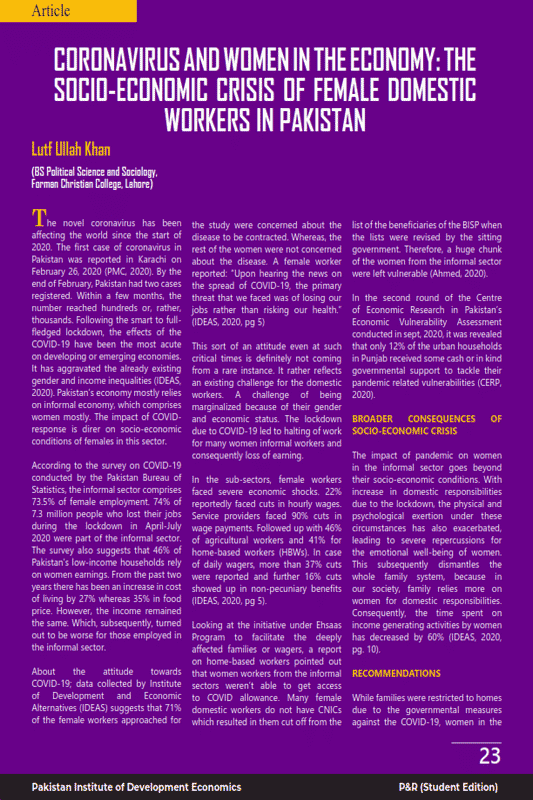
Pakistan Institute of Development Economics
- Home
Our Portals
MenuMenuMenuMenuMenuMenuMenu - ResearchMenuMenuMenuMenuMenuMenuMenu
- Discourse
- The PDR
- Our Researchers
- Academics
- Degree Verification
- Thesis Portal
- Our Portals
Coronavirus And Women In The Economy: The Socio-economic Crisis Of Female Domestic Workers In Pakistan
The novel coronavirus has been affecting the world since the start of 2020. The first case of coronavirus in Pakistan was reported in Karachi on February 26, 2020 (PMC, 2020). By the end of February, Pakistan had two cases registered. Within a few months, the number reached hundreds or, rather, thousands. Following the smart to full-fledged lockdown, the effects of the COVID-19 have been the most acute on developing or emerging economies. It has aggravated the already existing gender and income inequalities (IDEAS, 2020). Pakistan’s economy mostly relies on informal economy, which comprises women mostly. The impact of COVID-response is direr on socio-economic conditions of females in this sector.
According to the survey on COVID-19 conducted by the Pakistan Bureau of Statistics, the informal sector comprises 73.5% of female employment. 74% of 7.3 million people who lost their jobs during the lockdown in April-July 2020 were part of the informal sector. The survey also suggests that 46% of Pakistan’s low-income households rely on women earnings. From the past two years there has been an increase in cost of living by 27% whereas 35% in food price. However, the income remained the same. Which, subsequently, turned out to be worse for those employed in the informal sector.
About the attitude towards COVID-19; data collected by Institute of Development and Economic Alternatives (IDEAS) suggests that 71% of the female workers approached for the study were concerned about the disease to be contracted. Whereas, the rest of the women were not concerned about the disease. A female worker reported: “Upon hearing the news on the spread of COVID-19, the primary threat that we faced was of losing our jobs rather than risking our health.” (IDEAS, 2020, pg 5)
This sort of an attitude even at such critical times is definitely not coming from a rare instance. It rather reflects an existing challenge for the domestic workers. A challenge of being marginalized because of their gender and economic status. The lockdown due to COVID-19 led to halting of work for many women informal workers and consequently loss of earning.
In the sub-sectors, female workers faced severe economic shocks. 22% reportedly faced cuts in hourly wages. Service providers faced 90% cuts in wage payments. Followed up with 46% of agricultural workers and 41% for home-based workers (HBWs). In case of daily wagers, more than 37% cuts were reported and further 16% cuts showed up in non-pecuniary benefits (IDEAS, 2020, pg 5).
Looking at the initiative under Ehsaas Program to facilitate the deeply affected families or wagers, a report on home-based workers pointed out that women workers from the informal sectors weren’t able to get access to COVID allowance. Many female domestic workers do not have CNICs which resulted in them cut off from the list of the beneficiaries of the BISP when the lists were revised by the sitting government. Therefore, a huge chunk of the women from the informal sector were left vulnerable (Ahmed, 2020).
In the second round of the Centre of Economic Research in Pakistan’s Economic Vulnerability Assessment conducted in sept, 2020, it was revealed that only 12% of the urban households in Punjab received some cash or in kind governmental support to tackle their pandemic related vulnerabilities (CERP, 2020).
Broader consequences of socio-economic crisis:
The impact of pandemic on women in the informal sector goes beyond their socio-economic conditions. With increase in domestic responsibilities due to the lockdown, the physical and psychological exertion under these circumstances has also exacerbated, leading to severe repercussions for the emotional well-being of women. This subsequently dismantles the whole family system, because in our society, family relies more on women for domestic responsibilities. Consequently, the time spent on income generating activities by women has decreased by 60% (IDEAS, 2020, pg. 10).
Recommendations:
While families were restricted to homes due to the governmental measures against the COVID-19, women in the informal sector are likely be one of the last chunk of society to recover from the socio-economic crisis followed by the pandemic. Record suggests that the informal labor force is not recognized and contains no labor data. Therefore, they are not included in insurance and protection programs. It is, therefore, crucial for the informal workforce to be documented and prioritized in giving social security benefits by the policy and law makers.
- Labor force data to be improved and include informal workers so that the safety net such as Ehsaas and BISP and other social welfare organizations can be extended to female informal or home-based workers.
- Create a task force for women-centric economic recovery with the help of women chambers, private sectors and civil society organizations.
- A targeted public relation campaign urging economic recovery of the female in the informal sector through women-led enterprises.
References
Covid-19 & The new normal for women in the economy of Pakistan. Institute of Development And Economic Alternatives IDEAS, (2020) pg. 5-10
https://think-asia.org/bitstream/handle/11540/13335/Covid-19-The-New-Normal-for-Women-in-the-Economy-in-Pakistan.pdf?sequence=1
Covid-19 survey. Pakistan Bureau of Statistics
https://www.pbs.gov.pk/content/special-survey-evaluating-impact-covid-19
Ahmed, S. Irfan (2020), Home-bounds grasping at straws. The News.
https://www.thenews.com.pk/magazine/you/692867-home-bound-grasping-at-straws
Second Round (Sept-Oct 2020), Economic Vulnerability assessment. Centre of Economic Research in Pakistan.
https://www.cerp.org.pk/covid-economic-assessment/



